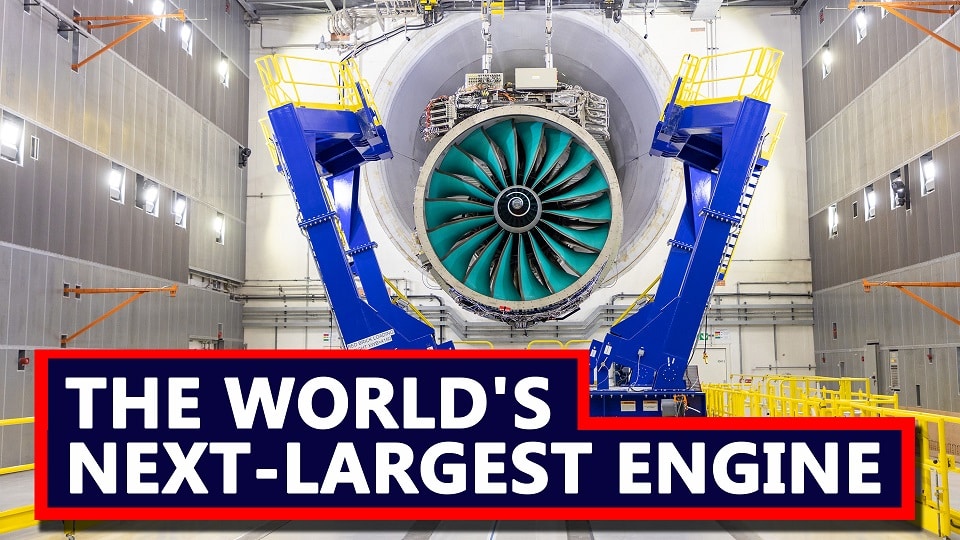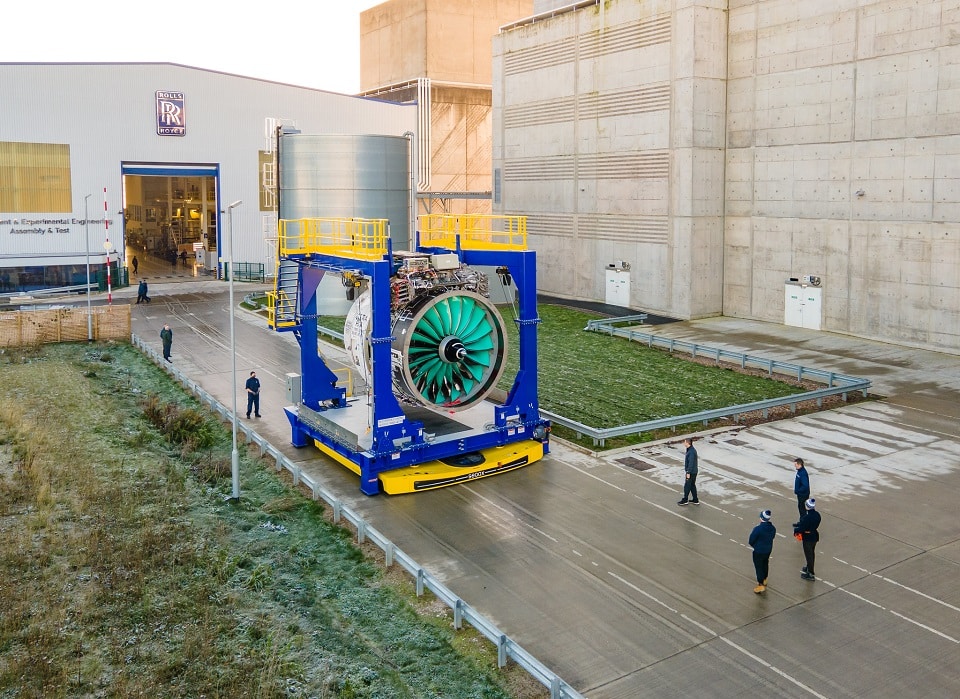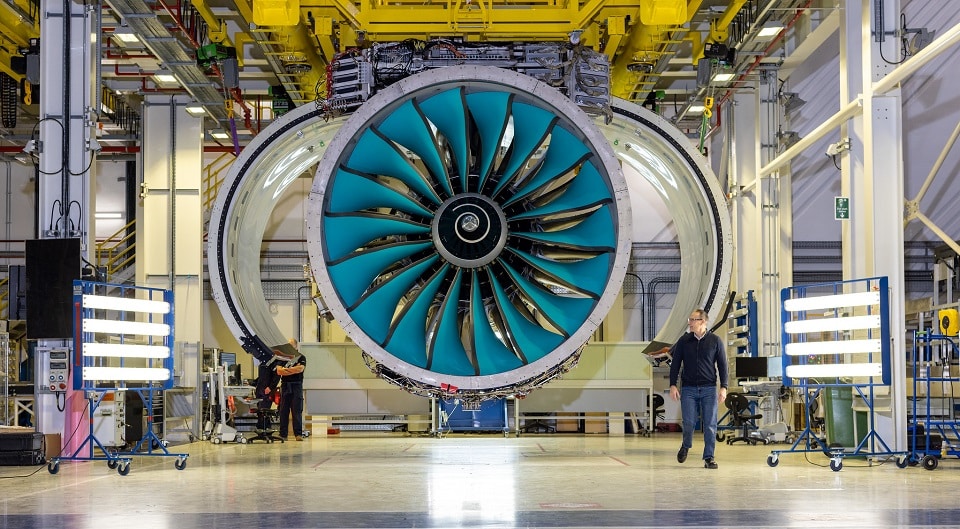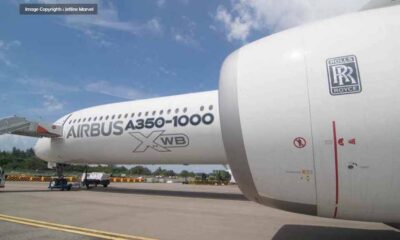Aerospace
The world’s largest engine The Rolls Royce UltraFan: 10 Key Takeaways.

Any aircraft’s basic component, on which its capacity and speed are largely dependent, is its engine. However, recently, the majority of aircraft companies have come under fire for significantly contributing to air pollution in the environment, which causes global warming and other problems.
As a result, companies like General Electric, Rolls Royce, Pratt & Whitney, and others are currently working on developing new types of engines that may both cut carbon emissions and improve operator productivity.
Airlines are concentrating more on sustainable fuel in the near future because it will be the only source that can replace the crude oils that come from the earth’s core and might potentially affect both the environment and our planet.
Therefore, aerospace companies are working to construct engines using 100 SAF fuel, which can be produced naturally in the environment and also causes less harm to the environment.
Rolls Royce in talks with DRDO to rev up AMCA engines(Opens in a new browser tab)
The first prototype of the UltraFan engine, which will be used in future aircraft, was completed by Rolls Royce in December. This engine’s innovation will undoubtedly aid in the achievement of net zero emissions for the environment and the aviation sector. We’ll look at a few fascinating facts about it in this article.
1. The biggest engine in the world
It is the biggest aviation engine Rolls Royce has ever produced, with a fan diameter of about 140 inches. This makes it bigger than the G9x engine, which is now mounted in the Boeing 777x and has a size of 134 inches.
The GE 9x engine has a thrust of roughly 490 kN, whereas this engine can generate 444.82 kN of thrust.
2.100% SAF-compatible engine
Additionally, the Rolls-Royce engine is compatible with 100% Sustainable Aviation Fuel, which will be used in the demonstrator’s first test early this year. Rolls Royce has also created engines for Gulfstream aircraft, which are currently also SAF-compatible. In addition, Rolls-Royce is intensively looking into hydrogen and hybrid electric power possibilities.
3. Fan constructed with hollow titanium blades.
Rolls-Royce fan blades are constructed from a unique composite material. Rolls-Royce will switch to carbon composite fan blades from its customary hollow titanium blades, which will result in a 340 kg (750 lb) weight reduction per engine. And because these blades operate at a low speed, they are unique.
4. A thrust reverser is not required for this engine.
This engine’s dual engine layout leads to a geared turbofan with a variable pitch fan system that promises an improvement in fuel burn of at least 25%. An overall pressure ratio of 70:1 and a bypass ratio of 15:1 are the goals of the geared/variable pitch UltraFan.
The Advance core is retained in the Ultrafan, which additionally features a geared turbofan architecture with variable-pitch fan blades. The fan won’t require a thrust reverser because it will adjust pitch to be most effective for each flying phase.
5. Low-pressure ratio fan operability will be facilitated by the variable pitch fan.
The initial test gear’s ratio will be close to 4:1, and its thrust could reach 440 kN. (100,000 lbf). Variable-pitch blades rather than a variable area jet nozzle are used to treat low-speed fan instability caused by higher bypass and a lower fan pressure ratio. Moreover, get rid of the thrust reverser.
6. the working of a rolls Royce ultra fan.
After the power gearbox, which generates secondary power thrust in a high-speed engine, the next section is the Advanced Core system, where compressed air will be generated, followed by lean burn combustion, and the last section is a High-Speed multi-stage IP turbine system.
The front fan operates at a low speed and is made of composite material. In comparison to Trent’s first generation, UltraFan is 25% more efficient, produces 40% less NOx, 35% less noise, and nearly no nvPM particles during cruising.
7. Are Rolls Royce and the GE 9x engine in competition?
This engine competes quite well with the GE9x engine, which has a similar engine but a somewhat higher thrust and speed ratio. The GE 9x engine was launched and is specifically intended for the Boeing 777x, but in the future, the RR engine might be one of the options for that engine.
However, we can’t say with certainty that this engine will also be installed in the Boeing 777x until we get more information. but I’m still unsure of it.
8. Rolls Royce constructed a unique engine test bed for €84 million ($94 million).
This engine needed a proper test bed and rolls to be tested. In order to understand how an engine behaves in various types of weather environments and tough foreign particulate inject testing, Rolls Royce is already preparing for testing in February 2023. In addition, the engine will undergo standby time testing, which could be crucial for any engine manufacturer.
The company built The cost of the specially built test equipment is €84 million ($94 million). Rolls-Royce has constructed a power rig near Dahlewitz, close to Berlin, with a capacity of 15–80 MW (20,000–107,000 hp) gear sets, simulating loading circumstances in flight;
9. UltraFan’s scalable technology
The engine will be employed in the upcoming aircraft, providing safe operations and 100% utilization of SAF fuel. increased efficiency and lower carbon emissions for airplanes let airlines increase their profits. UltraFan’s scalable technology from ~25,000-110,000lb thrust delivers the potential to further improve the fuel efficiency of both narrowbody and widebody aircraft by up to 10 percent.
10. UK and EU technology collaboration
In the nearer term, there are options to transfer technologies from the UltraFan development program to current Trent engines to deliver enhanced fuel efficiency and reductions in emissions. The UltraFan technology demonstrator program has been supported by the UK’s Aerospace Technology Institute and Innovate UK, the EU’s Clean Sky programs plus LuFo and the State of Brandenburg in Germany.
Read more: Click here

Aerospace
Indigo will soon launch Air Taxi Service in India

InterGlobe Enterprises, the parent brand of IndiGo, is set to revolutionize travel in India with its upcoming air taxi service.
Scheduled for a potential launch in 2026, this innovative venture promises a seamless journey for passengers between two bustling hubs. Delhi and Gurgaon in Haryana. The forthcoming service is projected to revolutionize the daily commute, offering passengers a swift aerial journey covering the distance in a mere 7 minutes.
This remarkable efficiency contrasts starkly with the conventional 90-minute drive, underscoring the immense time-saving potential for commuters. The anticipated fare, ranging from Rs 2,000-3,000, makes this innovative mode of transport not only swift but also remarkably competitive in pricing.
At the heart of this ambitious endeavor lies a strategic partnership with Archer Aviation, a pioneer in electric vertical takeoff and landing (eVTOL) aircraft technology. Under this collaboration, Archer will supply 200 state-of-the-art eVTOL aircraft, representing an investment of US$ 1 billion. These cutting-edge aircraft, capable of accommodating up to four passengers alongside the pilot, epitomize the future of sustainable air travel.
Powered by six battery packs, Archer’s eVTOL aircraft boast rapid charging capabilities, enabling a swift turnaround between flights. With a charging time of just 30-40 minutes, these eco-friendly aircraft ensure minimal downtime, maximizing operational efficiency.
Similar services are anticipated to be introduced by the joint venture in Bengaluru and Mumbai as well. Nevertheless, the service rollout period has not yet been made public by the company. Next year, it is anticipated to get its certification. Following this, the company will start the certification procedure with the Directorate General of Civil Aviation (DGCA).
Aerospace
Which is bigger 777x or 787 aircraft ?

The 777X is a new series of the Boeing 777 family and is designed to be larger and more efficient than its predecessor. It features two variants: the 777-8 and the 777-9, being the larger of the two.
The Boeing 777X emerges as the larger sibling within the Boeing family, representing a significant leap forward in both size and efficiency. Comprising two variants, the 777-8 and the 777-9, the latter takes the crown as the larger of the two. With its expansive fuselage and impressive wingspan, the 777X is tailored for long-range journeys and boasts a substantial passenger capacity.
On the other hand, the Boeing 787, affectionately known as the Dreamliner, occupies a niche in the market as a smaller yet formidable aircraft designed for medium to long-range flights. Its distinguishing feature lies in its composite fuselage, a technological marvel that renders it lighter and more fuel-efficient compared to conventional aluminum counterparts. The Boeing 777X is larger than the Boeing 787 aircraft.
When it comes to passenger capacity, the 777-9 reigns supreme, typically accommodating a sizeable contingent of 400-425 passengers in its standard configuration. In contrast, the 787, with its more modest dimensions, typically carries between 240-290 passengers, depending on the variant and layout.
One of the remarkable innovations introduced with the 777X is its folding wingtips, a feature designed to address the logistical challenges of accommodating such a large aircraft in conventional airport gates. These folding wingtips enable the 777X to retract its wings, allowing it to fit into gates designed for smaller aircraft while still reaping the benefits of an extended wingspan during flight, thereby enhancing fuel efficiency and operational flexibility
Aerospace
China Secures Production Certificate for Mass Production of Pilotless eVTOL Aircraft

The first passenger-carrying pilotless electric vertical takeoff and landing (eVTOL) aircraft in the world, the EH216-S, has received the Production Certificate for its eVTOL aircraft from the Civil Aviation Administration of China (CAAC).
This is a significant milestone for EHang Holdings Limited, the leading UAM technology platform company in the world. This outstanding accomplishment is another big step towards mass manufacturing for the eVTOL aircraft and the ensuing commercial operations, building on the ground-breaking acquisition of the Type Certificate and the Standard Airworthiness Certificate for the EH216-S.
The PC is a crucial certificate that the aircraft maker receives from the CAAC, the country’s aviation authority. By obtaining this certificate, EHang has demonstrated that it has set up a quality management system for mass production that satisfies the airworthiness regulation standards set forth by the CAAC, and the company has been given permission to continue producing mass quantities.
It is also a strong guarantee of the calibre of the goods made by EHang. Raw materials, supplier management, manufacturing organisation, production quality control, aircraft pre-delivery test, after-sales repair and maintenance, etc. are all included in the mass production quality management system for the EH216-S.
To ensure that every aircraft and its components that roll off the production line strictly adhere to the approved type design and safety requirements, the system sets clear guidelines and documentation for every step in the production procedure. This ensures comprehensive traceability and safety control.





























